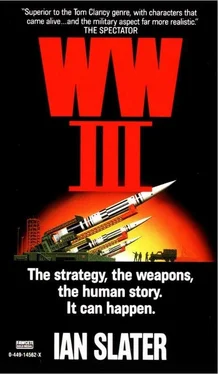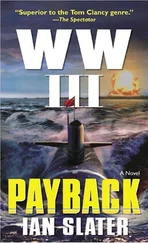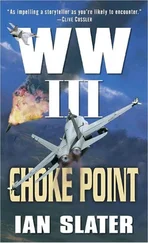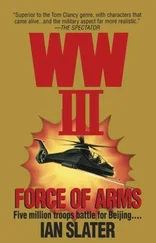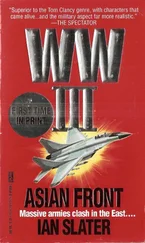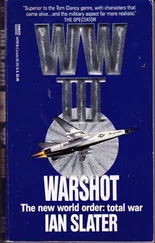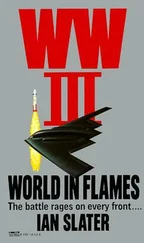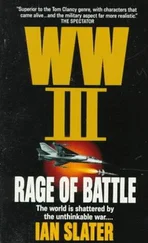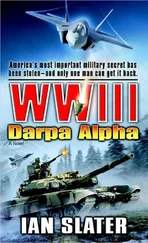Ian Slater - WW III
Здесь есть возможность читать онлайн «Ian Slater - WW III» весь текст электронной книги совершенно бесплатно (целиком полную версию без сокращений). В некоторых случаях можно слушать аудио, скачать через торрент в формате fb2 и присутствует краткое содержание. Год выпуска: 1990, ISBN: 1990, Издательство: Fawcett, Жанр: Триллер, на английском языке. Описание произведения, (предисловие) а так же отзывы посетителей доступны на портале библиотеки ЛибКат.
- Название:WW III
- Автор:
- Издательство:Fawcett
- Жанр:
- Год:1990
- ISBN:978-0449145623
- Рейтинг книги:3 / 5. Голосов: 1
-
Избранное:Добавить в избранное
- Отзывы:
-
Ваша оценка:
- 60
- 1
- 2
- 3
- 4
- 5
WW III: краткое содержание, описание и аннотация
Предлагаем к чтению аннотацию, описание, краткое содержание или предисловие (зависит от того, что написал сам автор книги «WW III»). Если вы не нашли необходимую информацию о книге — напишите в комментариях, мы постараемся отыскать её.
In Europe — Twenty Soviet Warsaw Pact infantry divisions and four thousand tanks begin to move. They are preceded by hundreds of strike aircraft. All are pointed toward the Fulda Gap. And World War III begins…
WW III — читать онлайн бесплатно полную книгу (весь текст) целиком
Ниже представлен текст книги, разбитый по страницам. Система сохранения места последней прочитанной страницы, позволяет с удобством читать онлайн бесплатно книгу «WW III», без необходимости каждый раз заново искать на чём Вы остановились. Поставьте закладку, и сможете в любой момент перейти на страницу, на которой закончили чтение.
Интервал:
Закладка:
As the ragtag U.S.-ROK army unit of less than six hundred men hurriedly assembled from the remains of Camp Libby clambered into armored personnel carriers setting out to counterattack the beach, they were about to become the first victims of what, in the dry technological jargon of ballistics research, was called the development of “improved sleeve design.” It was something that the doomed and already demoralized American and South Korean troops could only have known about if U.S. intelligence had penetrated an elite Soviet guard regiment. U.S. intelligence had not done so, and consequently there was no way for the men in the U.S.-ROK counterattack from Fort Libby to know that the new sleeve design for the standard Soviet and Chinese 7.62-millimeter round increased not only the velocity of the depleted uranium bullet but also its penetration capability.
On the beach at Pohang this meant that the very fast eight-and-a-half-ton American-built M-114 armored personnel carriers, each powered by an eight-cylinder Chevrolet engine and capable of transporting thirteen men, were stopped dead in their tracks. The NKA’s Soviet-made 7.62-millimeter rounds fired by Soviet-made PKM light machine guns not only penetrated the M-114s’ hulls but traveled so fast that even after penetration of the APCs’ hulls, a single ricochet inside the personnel carrier was capable of killing or wounding several men. A full burst often as not put the entire thirteen-man squad out of action.
The bloody scenes described later by a few survivors of the PKM slaughter of the M-114s could not begin to convey the extent of chaos and panic inside the jam-packed carriers, falling bodies and loose weapons often doing as much damage as the ricocheting 7.62-millimeters themselves.
From that time on, even though any objective assessment of the defeat of the American and ROK troops at Pohang Beach showed that this was due as much as anything to the overwhelming force and professionalism of the attacking NKA SPETS, blame shifted quickly to the inadequacies of the M-114s’ aluminum hulls. And, though the army would not admit it, after Pohang, U.S. and ROK commanders had great difficulty in persuading men to be transported to the front in the M-114s. The army kept touting the personnel carrier’s advantages, including its unmatched speed of fifty-eight kilometers per hour, but U.S. officers in all theaters remained unsuccessful in trying to have the carriers loaded to their full capacity of thirteen, the age-old superstition about the number thirteen reinforced by the disaster at Yongil Bay.
But if the penetrating 7.62-millimeters had surprised the U.S.-ROK forces at Pohang, this was as nothing to the far greater shock that was to come.
CHAPTER SIXTEEN
In Seoul, 225 miles northwest of Pohang, deep in the subterranean headquarters of the U.S.-ROK defense force, the extent of the NKA’s daring initiatives was only now being fully realized as field reports slowly found their way through the nightmare of a frantic bureaucracy and broken communications. One aspect of the invasion that was becoming clearer with each new report was how successful the coordination of the NKA’s attacks had been. One of the most difficult of all the military arts, such superb timing evidenced a professionalism that even dedicated anti-Communists like Cahill begrudgingly admired. For the civilian population, towering columns of black smoke seen all over the South were testimony enough of just how widespread and effective the NKA infiltrators and regulars had been.
However, the most stunning news in Seoul that morning of August 16 was that, following the NKA’s breakout southward through the tunnels, both pincers of Kim’s army had now reached Uijongbu junction. In all, two hundred thousand NKA troops were massing less than ten miles north of Seoul for the final surge down the Uijongbu corridor.
General Cahill knew that professionally he was finished unless he could buy time to pull a “MacArthur”: launch a massive amphibious assault at a weak point somewhere along North Korea’s western coastline and push inland, cutting the NKA’s supply line, which, due to their present rate of advance, might soon become dangerously overextended.
The initial reluctance of Seoul’s state-of-the-art headquarters to believe that a full-scale disaster might befall them originated in a faith, bordering on evangelical-like confidence, in “HiT-R,” or high-tech readiness. Cahill, General Lee, and the other commanders in the top echelon had relied too heavily on such indicators as vibration sensors along the DMZ. These, however, as predicted by Cahill’s aide, proved as deficient in the spongy terrain of the monsoon as they were efficient in the hard, frozen ground of winter, when any armoR-1ed invasion was supposed to happen. Now Seoul was relying heavily on two last “aces,” the first a direct and normally “militarily sound” tactical descendant of World War II: an elaborate system of high-explosive-rigged rail lines, culverts, highways, and bridges throughout the South. Where there were no natural culverts or bridges, enormous concrete slabs had been built either side of the highways. With all roads already assigned “code black,” all Cahill had to do was order the RECDET — remote control detonation — units to pull the switch and mountains of debris would come crashing down, forcing the NKA’s armored and motorized divisions to a standstill. And if the NKA’s armor couldn’t move, its infantry couldn’t advance in the face of the U.S.-ROK 105-millimeter artillery that was answering the Communists’ barrage.
At least this was the theory. The other “ace” Seoul HQ had up its sleeve was the Cobras. Two hundred of them, armed with GAU-8 armor-piercing thirty-millimeter cannons and Walleye antitank bombs, which, once the enemy tanks were identified by the on-ground laser source, would home in, riding down the beam, blowing the tank apart. Fifty were based at Kunsan a hundred miles away on the west coast, another fifty in the center at Taegu, the remaining hundred at Osan thirty miles south of Seoul.
Cahill’s disappointment was too much for him to bear when he heard they no longer existed. Many of the captured saboteurs, immediately executed by the ROK, had been “sleepers”— working at the various air bases for civilian contractors — and it wasn’t until an hour after the first NKA shells, shuffling through the air in their strangely muted staccato, had started crashing into the South Korean capital that the first reports about the Cobras reached Cahill among the pile of other sabotage reports and assorted debacles.
And it wasn’t until the radio message from Fort Alamo, a mile south of the DMZ, came in reporting firing in the distance but no breakthrough in their sector that Cahill and his staff realized the NKA had simply bypassed many American camps on or near the DMZ, leaving the isolated American strongholds for piecemeal destruction later on. It was the delay in such reports reaching him, rather than the contents of the reports as later charged, that made Cahill reluctant to signal Washington with a DEFCON 1 advisory — to put all U.S. forces on a war footing. With his communications in such chaos, verification of reported conditions at the front was at times impossible, and the last thing he had wanted was to be accused of panic. He also knew it was possible the NKA was feeding false information. He had assumed, for example, in accordance with his standing orders, that at least half the Cobras would already be in the air shortly after hostilities began, with “weapons freed” clearance and in action all along the DMZ. What had actually happened, and what Cahill wasn’t told until three hours later, was that while the first messages from Osan reported only a few helos afire, in fact, most of the remaining choppers had been destroyed by either mortar splinters or infiltrator sniper fire. What had fooled those reporting the damage was that so few choppers were on fire. But this was not due to any lack of shrapnel or snipers but to the Cobra’s plastic inert gas fuel tanks, their honeycombed interior specifically designed not to burst into flame when fired upon. It was only later, after ground crew felt safe enough to go out on the tarmac, that they discovered the extent of the damage, the Cobras riddled by rifle fire that had easily passed through the thin fuselage, slicing and mashing the maze of electronics and hydraulically operated controls.
Читать дальшеИнтервал:
Закладка:
Похожие книги на «WW III»
Представляем Вашему вниманию похожие книги на «WW III» списком для выбора. Мы отобрали схожую по названию и смыслу литературу в надежде предоставить читателям больше вариантов отыскать новые, интересные, ещё непрочитанные произведения.
Обсуждение, отзывы о книге «WW III» и просто собственные мнения читателей. Оставьте ваши комментарии, напишите, что Вы думаете о произведении, его смысле или главных героях. Укажите что конкретно понравилось, а что нет, и почему Вы так считаете.
